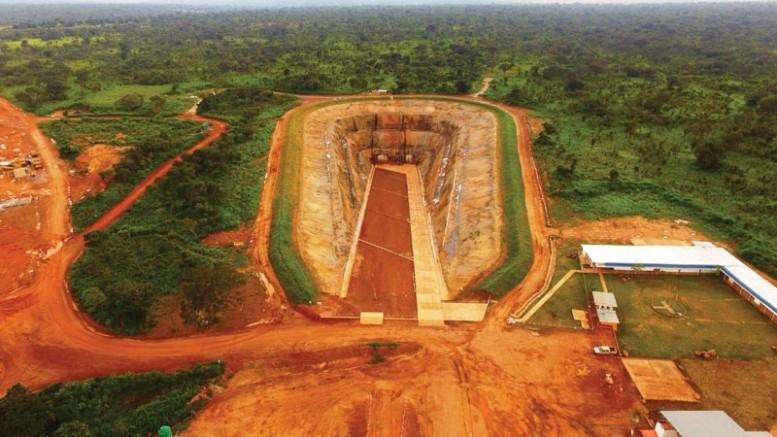VANCOUVER — With a positive prefeasibility study in hand, Vancouver-based Ivanhoe Mines (TSX: IVN; US-OTC: IVPAF) and Chinese partner Zijin Mining Group are another step closer to developing Kamoa, the world’s largest, undeveloped copper resource in the Democratic Republic of the Congo (DRC).
The study examines first exploiting the shallow, high-grade part of the sediment-hosted copper deposit at Kansoko Sud, which holds 71.9 million “probable” tonnes at 3.9% copper, or 5.1 billion lb. copper, assuming a 1% cut-off.
The partners would need US$1.2 billion to build the underground mine, but the study envisages a 4.6-year payback, an after-tax net present value (NPV), at an 8% discount rate, of US$986 million, and a 17.2% after-tax internal rate of return (IRR).
“We know of no other copper project in the world that offers the potential of multi-decade, large-scale, mechanized production from a near-surface, stratiform deposit grading nearly 4% copper,” Robert Friedland, executive chairman of Ivanhoe, said in the press release.
In advance of the study, the partners had completed box cuts for the declines that would access Kansoko Sud, although there’s no timeline for construction.
Ivanhoe estimates it would take the operation 24 years operating at 3 million tonnes per annum and producing 100,000 tonnes copper per year to exhaust the “reserve”, but that’s little compared to the 52.9 billion lb. copper in the rest of the deposit.
The study notes that indicated and inferred resources at Kamoa — which are based on 400- and 800-metre drill centres — weigh in at 752 million indicated tonnes of 2.7% copper and 190 million indicated tonnes of 3.1% copper, using a 1% cut-off grade.
The study reveals that Kamoa’s economics are sensitive to the copper price.
At US$2.50 per lb. copper, NPV slides to US$336 million, and at US$2 per lb. copper, drops even more to negative US$340 million.
On the upside, anticipated total cash costs are low at US$1.48 per lb. copper.
If the miners switch to “controlled convergence” room-and-pillar mining, NPV rises to US$1.2 billion and IRR to 18.9%, assuming the same metrics.
The production scenario in the prefeasibility study represents only a first phase of mining at Kamoa, whereas a second phase would entail a major expansion of the mine and mill, and building a smelter to make blister copper.
Although details on the second phase weren’t included in this latest study, a preliminary economic study in 2013 envisaged ramping up to mine 8 million tonnes per annum — or 306,000 blister tonnes copper — in year five of production, making it one of the world’s largest copper mines, with the highest grade.
The estimated expansion cost is US$3.5 billion, according to the preliminary assessment.
The partners can also stick to the shallow, high-grade mining centres in and around Kamoa, such as at the new Kakula deposit, 5 km southeast.
Ivanhoe announced the discovery in January, backed by drill intercepts that are some of the highest grade and thickest ever drilled at Kamoa.
One hole returned 24.1 metres true width of 3.5% copper at a 1% copper cut-off. At a 2% copper cut-off, the intersection was 13.1 metres true width of 5.3% copper.
Another hole cut 18.5 metres true width of 4.6% copper at a 1% copper cut-off and 14.9 metres true width of 5.3% copper at a 2% copper cut-off.
The two holes were 400-metre stepouts from 13.5 metres true width of 4.2% copper at a 2% copper cut-off.
“It’s early days, but the potential for having a substantial area of 10 to 15 metres with good grades is obviously exciting,” David Broughton, executive vice-president of exploration with Ivanhoe, tells The Northern Miner during a phone interview, noting that average widths at Kamoa measure between 3.9 and 5.2 metres true width. “The bottom line is that along this trend and within our 400 sq. km mining licence, we clearly have the potential for significant, different resource areas,” he says.
Kamoa is one of many world-class copper deposits scattered within a sedimentary rock belt that straddles the border between Zambia and the DRC.
The Central African Copperbelt, as it’s known, was blanketed in copper during the Neoproterozoic — a unique time when the earth’s major land masses, then positioned along warmer latitudes, broke apart into huge ocean basins.
For tens of millions of years, brackish and oxidizing groundwaters stripped any available metal from the sediments that collected in the basins, eventually depositing them along contacts with reducing strata that served as a chemical trap.
In the Copperbelt, explorers long believed that the most ideal trap for the ancient, copper-rich groundwater occurred within a part of the stratigraphy called the mine’s “sub-member of the Roan formation.”
However, Ivanhoe broke the status quo in 2008 when it discovered that mineralization at Kamoa resides within a part of the stratigraphy explorers thought was barren, offering a brand-new shade to the blue-sky potential across Kamoa’s 400 sq. km mining licence.
“The Kamoa area is really like a new district, it’s geologically different from the Congolese part of the Copperbelt to the east, and again the Zambian part of the belt to the south and far east,” he says. “But similar to those other districts, it now has evidence of multiple areas with mining potential, and that’s a credit to our team in Congo.”


Be the first to comment on "Ivanhoe, Zijin wrap up prefeasibility study at Kamoa in DRC"